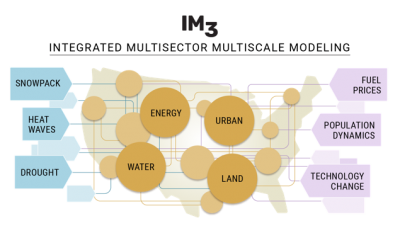Integrated Multisector, Multiscale Modeling (IM3) Scientific Focus Area
Project Team
Principal Investigator
Collaborative Institutional Lead
Project Participant
The Integrated Multisector, Multiscale Modeling (IM3) Scientific Focus Area (SFA) has the following long-term objectives:
- Develop flexible, open-source, integrated modeling capabilities that capture the structure, dynamic behavior, and emergent properties of the multiscale interactions within and between human and natural systems.
- Use these capabilities to study the evolution, vulnerability, and resilience of interacting human and natural systems and landscapes from local to continental scales, including their responses to the compounding effects of long-term influences and short-term shocks.
- Understand the implications of uncertainty in data, observations, models, and model coupling approaches for projections of human-natural system dynamics.
Launched in 2017, IM3’s research through FY20 included:
- Energy and water system dynamics modeling, at scales ranging from watershed to regional to simulate water availability interactions with electricity system operations
- Modeling of the complex, multiscale linkages between land use and land cover change (LULCC), hydrology, and regional climate
- Development of high-resolution U.S. population projections sensitive to state-level demographic projections
- Scalable building energy demand modeling responsive to population, building technology, and weather
- Agent-based modeling to simulate emergent behavior in water management, crop planting, and urban-rural transition decisions
- City-specific and contiguous U.S. (CONUS)-scale studies of urban heat islands, anthropogenic heat feedbacks, and adaptation strategies
- Developing best practices for multi-model coupling, version control, and uncertainty characterization
- Founding a community of practice to support the MultiSector Dynamics research community
In its current phase (through FY23), IM3 will explore the following research gaps in our understanding of multisector dynamics:
Heat Waves and Urban Vulnerability
- Population vulnerabilities to the impacts of extreme heat at subnational scale remain underrepresented.
- Previous regional-scale electricity demand projections have not addressed the impacts of heat waves on building thermodynamics.
Drought and Adaptation
- Previous studies have not addressed multiscale dynamic interactions and conjunctive management of surface water and groundwater resources under compound natural and human influences.
- There is a lack of representation of human adaptation to water scarcity in terms of both water use and water management decisions.
- LULCC and its impact on water demand/supply are not yet propagated through other sectors nor across scales.
Compound Effects of Heat Waves and Drought on the Electric Grid
- Current electricity infrastructure expansion models are unable to simultaneously address short- and long-term stressors with the spatial and temporal resolution necessary to demonstrate that the future infrastructure can meet future demand with sufficient reliability and reasonable cost.
- There is little understanding of how the compound influences of drought and heat waves interact to create cascading failures and non-linear responses.
Uncertainty Characterization
- There is a lack of guidance for confronting the computational and conceptual challenges of multi-model uncertainty characterization (UC) workflows.
IM3 is pursuing these research gaps with different degrees of spatial, temporal, and process resolution and at the following scales: CONUS, electricity grid interconnection, watershed, and urban. Our approach emphasizes leveraging existing efforts and emerging capabilities, systematically increasing complexity, and engaging with a range of communities to help establish this SFA as a long-term home for cutting-edge multisector dynamics research. Ultimately, our goal is to dramatically improve scientific understanding of how the complex coupled human-Earth system responds to different stresses, which will in turn inform decision-making across a range of sectors and scales.

